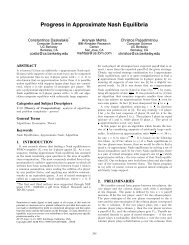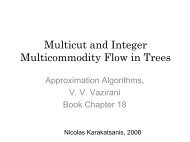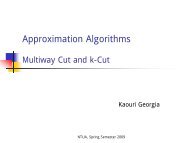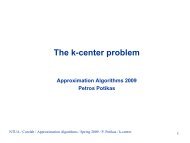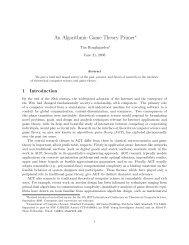Settling the Complexity of 2-Player Nash-Equilibrium - ECCC ...
Settling the Complexity of 2-Player Nash-Equilibrium - ECCC ...
Settling the Complexity of 2-Player Nash-Equilibrium - ECCC ...
You also want an ePaper? Increase the reach of your titles
YUMPU automatically turns print PDFs into web optimized ePapers that Google loves.
Electronic Colloquium on Computational <strong>Complexity</strong>, Revision 1 <strong>of</strong> Report No. 140 (2005)<br />
<strong>Settling</strong> <strong>the</strong> <strong>Complexity</strong> <strong>of</strong> 2-<strong>Player</strong><br />
<strong>Nash</strong>-<strong>Equilibrium</strong><br />
Xi Chen<br />
Department <strong>of</strong> Computer Science<br />
Tsinghua University<br />
Beijing, P.R.China<br />
xichen00@mails.tsinghua.edu.cn<br />
Xiaotie Deng<br />
Department <strong>of</strong> Computer Science<br />
City University <strong>of</strong> Hong Kong<br />
Hong Kong SAR, P.R.China<br />
deng@cs.cityu.edu.hk<br />
Abstract<br />
We prove that finding a solution <strong>of</strong> two player <strong>Nash</strong> <strong>Equilibrium</strong> is PPAD-complete.<br />
1 Introduction<br />
Almost sixty years ago Morgenstern and von Neumann [14] initiated <strong>the</strong> study <strong>of</strong> game <strong>the</strong>ory<br />
with <strong>the</strong>ir applications to Economic behavior. A particularly interesting ma<strong>the</strong>matical result<br />
is <strong>the</strong>ir pro<strong>of</strong> <strong>of</strong> <strong>the</strong> existence <strong>of</strong> equilibrium in <strong>the</strong> 2-player zero-sum game model where one<br />
player’s gain is <strong>the</strong> loss <strong>of</strong> <strong>the</strong> o<strong>the</strong>r. They exploit duality properties <strong>of</strong> polytopes, which also<br />
lead to Dantzig’s linear programming method [6] for optimization problems, as well as Yao’s<br />
principle [17] for finding algorithmic lower bounds. <strong>Nash</strong> proposed in <strong>the</strong> middle <strong>of</strong> <strong>the</strong> last<br />
century to study <strong>the</strong> more general multiple person game model, and proved that <strong>the</strong>re exists<br />
a set <strong>of</strong> (mixed) strategies, now called <strong>Nash</strong>-equilibrium point, one for each player, such that<br />
no player can benefit if it changes its own strategy unilaterally. While 2-player zero-sum game<br />
has a polynomial-time algorithm since linear programming has one, as by Khachian’s ellipsoid<br />
algorithm [12], <strong>the</strong> existence pro<strong>of</strong> <strong>of</strong> <strong>Nash</strong> equilibrium relied on <strong>the</strong> Kakutani’s fixed point<br />
<strong>the</strong>orem (a generalization <strong>of</strong> <strong>the</strong> Brouwer’s fixed point <strong>the</strong>orem [1]) which does not admit any<br />
polynomial-time algorithm [3, 10]. Despite much effort on <strong>the</strong> important problem, no significant<br />
progress has been made on algorithms for <strong>the</strong> original <strong>Nash</strong>-equilibrium problem in <strong>the</strong><br />
last half century, though both hardness results and polynomial-time algorithms have been derived<br />
for various modified versions.<br />
An exciting breakthrough was announced a few weeks ago which stated that finding <strong>Nash</strong><br />
equilibriums is indeed hard, by Daskalakis, Goldberg and Papadimitriou [7], for games with<br />
four players or more. An ɛ approximation version was proven to be complete in <strong>the</strong> PPAD (<br />
polynomial parity argument, directed version) class, introduced by Papadimitriou in his seminal<br />
work about fifteen years ago [15]. The work was improved to <strong>the</strong> 3-player case by Chen and<br />
1<br />
ISSN 1433-8092
Deng [4], Daskalakis and Papadimitriou [8], independently, and with different pro<strong>of</strong>s. Those<br />
results leave <strong>the</strong> two player <strong>Nash</strong>-equilibrium <strong>the</strong> last opening problem in <strong>the</strong> long sequel <strong>of</strong><br />
search for an efficient solution.<br />
Finding a <strong>Nash</strong>-equilibrium in a game between two players could be easier for several reasons.<br />
First, <strong>the</strong> zero-sum version can be solved in polynomial time by linear programming.<br />
Secondly, it admits a polynomial size rational number solution [5] while games between three<br />
or more players may only have solutions all in irrational numbers. Finally, an important technique<br />
employed in <strong>the</strong> hardness pro<strong>of</strong>s, that colors vertices <strong>of</strong> a graphical game, does not seem<br />
possible to work down to <strong>the</strong> case <strong>of</strong> two players.<br />
In this work, we settle <strong>the</strong> problem with a PPAD-complete pro<strong>of</strong> for <strong>the</strong> 2-player <strong>Nash</strong>equilibrium<br />
problem (2-<strong>Nash</strong>). Our pro<strong>of</strong> gets rid <strong>of</strong> <strong>the</strong> graphical game model, and derives<br />
a direct reduction from 3-Dimensional Brouwer to 2-<strong>Nash</strong>. We need to design new gadgets<br />
for various arithmetic and logic operations [7], but <strong>the</strong>y all work well in <strong>the</strong> new setting.<br />
Noticeably, an exact equilibrium is an approximate equilibrium in <strong>the</strong> definition <strong>of</strong> r-<strong>Nash</strong>.<br />
Therefore, <strong>the</strong> problem <strong>of</strong> finding an exact <strong>Nash</strong> equilibrium in a game between two players<br />
(which is denoted by <strong>Nash</strong> in [16]) is PPAD-hard. On <strong>the</strong> o<strong>the</strong>r hand, it was known by<br />
Cottle and Danzig [5] that <strong>the</strong> two player case admits a polynomial size rational solution and<br />
problem <strong>Nash</strong> is in PPAD [16]. Our result immediately implies that <strong>Nash</strong> is complete in<br />
PPAD, which settles a long standing open problem.<br />
The paper is arranged as follows: We review <strong>the</strong> necessary definitions in Section 2. In section<br />
3, we summarize <strong>the</strong> reduction from 3-Dimensional Brouwer to 3-Graphical <strong>Nash</strong><br />
in [7], in particular <strong>the</strong> types <strong>of</strong> gadgets required by <strong>the</strong> reduction. In Section 4, we present<br />
our new gadgets and prove <strong>the</strong> correctness <strong>of</strong> <strong>the</strong> reduction. We conclude in Section 5 with<br />
remarks and discussion.<br />
2 Preliminaries<br />
2.1 Games, Graphical Games and <strong>Nash</strong> <strong>Equilibrium</strong>s<br />
A game G between r ≥ 2 players is composed <strong>of</strong> two parts. First, every player p ∈ [r] where<br />
[r] = { 0, 1, ... r } has a set S p <strong>of</strong> pure strategies. Second, for each p ∈ [r] and s ∈ S where<br />
S = S 1 × S 2 × ... × S r ,<br />
we have u p s as <strong>the</strong> pay<strong>of</strong>f or utility <strong>of</strong> player p. Here s is called a pure strategy pr<strong>of</strong>ile <strong>of</strong> <strong>the</strong><br />
game. For any p, we use S −p to denote <strong>the</strong> set <strong>of</strong> all strategy pr<strong>of</strong>iles <strong>of</strong> players o<strong>the</strong>r than<br />
p. For any j ∈ S p and s ∈ S −p , we use js to denote <strong>the</strong> pure strategy pr<strong>of</strong>ile in S, which is<br />
combined by j and s. A mixed strategy x p <strong>of</strong> player p is a probability distribution over S p ,<br />
that is, real numbers x p j ≥ 0 for any j ∈ S p and ∑ j∈S p<br />
x p j<br />
= 1. A pr<strong>of</strong>ile <strong>of</strong> mixed strategies<br />
p <strong>of</strong> game G consists <strong>of</strong> r mixed strategies x p , p = 1, 2, ... r. For any p ∈ [r], x p is a mixed<br />
2
strategy <strong>of</strong> player p. For any p ∈ [r] and s ∈ S −p , we define x s as<br />
x s =<br />
∏<br />
p ′ ∈[r], p ′ ≠p<br />
Now we give <strong>the</strong> definition <strong>of</strong> both accurate and approximate <strong>Nash</strong> equilibriums <strong>of</strong> a game.<br />
Intuitively, a <strong>Nash</strong> equilibrium is a pr<strong>of</strong>ile <strong>of</strong> mixed strategies p such that no player can gain<br />
by unilaterally choosing a different mixed strategy, while o<strong>the</strong>r mixed strategies in <strong>the</strong> pr<strong>of</strong>ile<br />
are kept fixed. The concept <strong>of</strong> approximate <strong>Nash</strong>-equilibrium here was first proposed by [16].<br />
Definition 1. A <strong>Nash</strong> equilibrium <strong>of</strong> G is a pr<strong>of</strong>ile <strong>of</strong> mixed strategies p = {x p } such that<br />
∑<br />
s∈S −p<br />
u p is x s > ∑<br />
s∈S −p<br />
u p js x s =⇒ x p j = 0<br />
for any p ∈ [r] and i, j ∈ S p .<br />
Definition 2. An ɛ-<strong>Nash</strong> equilibrium <strong>of</strong> G is a pr<strong>of</strong>ile <strong>of</strong> mixed strategies p = {x p } such that<br />
for any p ∈ [r] and i, j ∈ S p .<br />
∑<br />
u p is x s > ∑<br />
s∈S −p<br />
x p′<br />
s p ′<br />
s∈S −p<br />
u p js x s + ɛ =⇒ x p j = 0<br />
A useful class <strong>of</strong> games are graphical games, which was first defined in [11] and <strong>the</strong>n generalized<br />
by [9]. <strong>Player</strong>s in a graphical game are vertices <strong>of</strong> an underlying directed graph G.<br />
A player u can affect <strong>the</strong> pay<strong>of</strong>fs <strong>of</strong> player v only if uv ∈ G. While general games require<br />
exponential data for <strong>the</strong>ir descriptions, graphical games have succinct representations. More<br />
exactly, when <strong>the</strong> in-degree <strong>of</strong> <strong>the</strong> underlying graph G is bounded, <strong>the</strong> representation <strong>of</strong> a<br />
graphical game is polynomial in <strong>the</strong> number <strong>of</strong> players and strategies.<br />
2.2 TFNP, PPAD and r-<strong>Nash</strong><br />
Let R ⊂ Σ ∗ × Σ ∗ be a polynomial-time computable, polynomially balanced relation (that is,<br />
<strong>the</strong>re exists a polynomial p such that for any x and y satisfy (x, y) ∈ R, |y| ≤ p(|x|)). The<br />
NP search problem Q R specified by R is this : given input x ∈ Σ ∗ , return a y ∈ Σ ∗ such that<br />
(x, y) ∈ R if such a y exists, and return <strong>the</strong> string “no” o<strong>the</strong>rwise. An NP search problem<br />
is said to be total if for every x, <strong>the</strong>re exists a y such that (x, y) ∈ R. We use TFNP [13]<br />
to denote <strong>the</strong> class <strong>of</strong> total NP search problems.<br />
Definition 3. Given two problems Q R1 , Q R2 ∈ TFNP, we say that Q R1 is reducible to Q R2<br />
if <strong>the</strong>re exists a pair <strong>of</strong> polynomial-time computable functions (f, g) such that, for every input<br />
x <strong>of</strong> R 1 , if y satisfies (f(x), y) ∈ R 2 , <strong>the</strong>n (x, g(y)) ∈ R 1 .<br />
One <strong>of</strong> <strong>the</strong> most interesting sub-classes <strong>of</strong> TFNP is PPAD which is <strong>the</strong> directed version<br />
<strong>of</strong> class PPA. The totality <strong>of</strong> problems in PPAD is guaranteed by <strong>the</strong> following trivial fact:<br />
in a directed graph, where <strong>the</strong> in-degree and out-degree <strong>of</strong> every vertex are no more than one,<br />
3
if <strong>the</strong>re exists a source, <strong>the</strong>re must be ano<strong>the</strong>r source or sink. Many important problems were<br />
identified to be in PPAD [16], e.g. <strong>the</strong> search versions <strong>of</strong> Brouwer’s fixed point <strong>the</strong>orem,<br />
Kakutani’s fixed point <strong>the</strong>orem, Smith’s <strong>the</strong>orem and Borsuk-Ulam <strong>the</strong>orem. r-<strong>Nash</strong>, that<br />
is, <strong>the</strong> problem <strong>of</strong> finding an approximate <strong>Nash</strong> equilibrium in a game between r players, also<br />
belongs to PPAD [16].<br />
Definition 4. The input <strong>of</strong> problem r-<strong>Nash</strong> is a pair (G, 0 k ) where G is an r-player game in<br />
normal form, and <strong>the</strong> output is a (1/2 k )-<strong>Nash</strong> equilibrium <strong>of</strong> game G. The input <strong>of</strong> <strong>Nash</strong> is a<br />
2-player game G in normal form, and <strong>the</strong> output is an exact <strong>Nash</strong> equilibrium <strong>of</strong> G.<br />
3 Review <strong>of</strong> <strong>the</strong> Reduction in [7]<br />
In this section, we briefly review <strong>the</strong> reduction from problem 3-Dimensional Brouwer to<br />
3-Graphical <strong>Nash</strong> in [7]. First, we define <strong>the</strong> search problem 3-Dimensional Brouwer.<br />
Definition 5 (3-Dimensional Brouwer). The input <strong>of</strong> <strong>the</strong> problem is a pair (C, 0 n ) where<br />
C is a circuit with 3n input bits and 6 output bits ∆x + , ∆x − , ∆y + , ∆y − , ∆z + and ∆z − . It<br />
specifies a Brouwer function φ <strong>of</strong> a very special form. For any 0 ≤ i, j, k ≤ 2 n − 1, we define a<br />
cubelet K ijk in <strong>the</strong> unit cube [0, 1] 3 as<br />
{<br />
}<br />
K ijk = (x, y, z) ∣ i2 −n ≤ x ≤ (i + 1)2 −n , j2 −n ≤ y ≤ (j + 1)2 −n , k2 −n ≤ z ≤ (k + 1)2 −n<br />
and use c ijk to denote its center. Brouwer function φ is a function on <strong>the</strong> set <strong>of</strong> centers. For<br />
any c ijk , φ(c ijk ) = c ijk + δ where δ is one <strong>of</strong> <strong>the</strong> four increment vectors δ 1 , δ 2 , δ 3 , δ 4 below,<br />
and is specified by <strong>the</strong> 6 output bits <strong>of</strong> C(i, j, k) as follows:<br />
case 1 : ∆x + = 1 and o<strong>the</strong>r five bits are 0 =⇒ δ = δ 1 = (α, 0, 0);<br />
case 2 : ∆y + = 1 and o<strong>the</strong>r five bits are 0 =⇒ δ = δ 2 = (0, α, 0);<br />
case 3 : ∆z + = 1 and o<strong>the</strong>r five bits are 0 =⇒ δ = δ 3 = (0, 0, α);<br />
case 4 : ∆x − = ∆y − = ∆z − = 1 and o<strong>the</strong>r three bits are 0 =⇒ δ = δ 4 = (−α, −α, −α),<br />
where α = 2 −2n is much smaller than <strong>the</strong> cubelet side. For any 0 ≤ i, j, k ≤ 2 n − 1, <strong>the</strong> six<br />
output bits <strong>of</strong> C(i, j, k) are guaranteed to be one <strong>of</strong> <strong>the</strong> four cases above, and C satisfies <strong>the</strong><br />
following conditions on <strong>the</strong> boundary:<br />
φ(c 0jk ) = c 0jk + δ 1 φ(c i0k ) = c i0k + δ 2 φ(c ij0 ) = c ij0 + δ 3<br />
φ(c (2 n −1)jk) = c (2 n −1)jk + δ 4 φ(c i(2 n −1)k) = c i(2 n −1)k + δ 4 φ(c ij(2 n −1)) = c ij(2 n −1) + δ 4<br />
with conflicts resolved arbitrarily. A vertex <strong>of</strong> a cubelet is said to be panchromatic if, among<br />
<strong>the</strong> eight cubelets adjacent to it, <strong>the</strong>re are four that have all four increments δ 1 , δ 2 , δ 3 and δ 4 .<br />
The output <strong>of</strong> <strong>the</strong> problem is a panchromatic vertex <strong>of</strong> φ which is specified by (C, 0 n ).<br />
Theorem 1 ([7]). Search problem 3-Dimensional Brouwer is PPAD-complete.<br />
4
In [7], a binary graphical game GG with degree 3 is constructed from (C, 0 n ). Given any<br />
2 −4n -<strong>Nash</strong> equilibrium <strong>of</strong> GG, a panchromatic vertex <strong>of</strong> (C, 0 n ) can be identified efficiently.<br />
There are two kinds <strong>of</strong> vertices in GG, arithmetic vertices and interior vertices. For any<br />
arithmetic vertex v, p[v] is a meaningful real number in any <strong>Nash</strong> equilibrium p, where p[v]<br />
is <strong>the</strong> probability <strong>of</strong> v choosing strategy 1. Gadgets are designed to implement arithmetic and<br />
logic operations among arithmetic vertices, and interior vertices are used to mediate between<br />
arithmetic vertices, so that <strong>the</strong> latter ones obey <strong>the</strong> intended arithmetic relationship.<br />
Totally 9 gadgets are necessary, i.e. G ζ , G ×ζ , G = , G + , G − , G < , G ∧ , G ∨ and G ¬ . Every<br />
gadget contains both arithmetic vertices and interior vertices. Fur<strong>the</strong>rmore, arithmetic vertices<br />
in a gadget are classified as input vertices and output vertices. For example, a G + gadget<br />
contains 4 vertices v 1 , v 2 , v 3 and w where w is an interior vertex and o<strong>the</strong>rs are arithmetic<br />
vertices. v 3 is <strong>the</strong> output vertex <strong>of</strong> G + and v 1 , v 2 are both input vertices. A gadget only decide<br />
pay<strong>of</strong>fs <strong>of</strong> its interior vertex and output vertex. For example, by saying adding a G + gadget,<br />
we actually setup <strong>the</strong> pay<strong>of</strong>fs <strong>of</strong> v 3 and w, so that in any ɛ-<strong>Nash</strong> equilibrium <strong>of</strong> GG, we have<br />
p[v 3 ] = max(p[v 1 ] + p[v 2 ], 1) ± ɛ. For any arithmetic vertex v, <strong>the</strong>re exists exactly one gadget<br />
<strong>of</strong> which v is <strong>the</strong> output vertex, while it can be an input vertex <strong>of</strong> arbitrarily many gadgets.<br />
The main idea in <strong>the</strong> construction <strong>of</strong> GG comes from <strong>the</strong> following observation:<br />
Let p = (x, y, z) be a point in <strong>the</strong> unit cube. If <strong>the</strong> increment <strong>of</strong> function φ at p<br />
( interpolated from centers <strong>of</strong> <strong>the</strong> adjacent cubelets ) is close enough to zero, <strong>the</strong>n<br />
<strong>the</strong>re must exist a panchromatic vertex <strong>of</strong> Brouwer function φ near point p.<br />
There are three distinguished vertices v x , v y and v z which encode a point p in <strong>the</strong> unit cube.<br />
After extracting <strong>the</strong> 3n bits <strong>of</strong> p[v x ], p[v y ] and p[v z ], we simulate circuit C with logic gadgets<br />
G ∧ , G ∨ , G ¬ and calculate <strong>the</strong> increment vector <strong>of</strong> φ. The above computation is repeated for<br />
41 3 points around (p[v x ], p[v y ], p[v z ]), and all <strong>the</strong> vectors are averaged as <strong>the</strong> displacement <strong>of</strong><br />
φ at p. Finally, we add it to p[v x ], p[v y ], p[v z ], and use G = to make sure that, in any ɛ-<strong>Nash</strong><br />
equilibrium, <strong>the</strong> displacement <strong>of</strong> φ at p is very close to zero. The averaging maneuver used in<br />
<strong>the</strong> interpolation here also resolves <strong>the</strong> problem caused by <strong>the</strong> brittle comparator G < .<br />
Let k 0 be an integer such that, for any input pair (C, 0 n ) <strong>of</strong> 3-Dimensional Brouwer,<br />
<strong>the</strong> number <strong>of</strong> arithmetic vertices in <strong>the</strong> graphical game GG ≤ ∣ ∣ (C, 0 n ) ∣ ∣ k0 .<br />
The hardness pro<strong>of</strong> <strong>of</strong> 4-<strong>Nash</strong> in [7] is based on a combined reduction from 3-Dimensional<br />
Brouwer to 3-Graphical <strong>Nash</strong> to 4-<strong>Nash</strong>. In this work, we developed new structures (<br />
which are called nodes here) to perform <strong>the</strong> task <strong>of</strong> vertices in <strong>the</strong> reduction above. Gadgets<br />
are designed in <strong>the</strong> new setting, which allow us to directly reduce 3-Dimensional Brouwer<br />
to 2-<strong>Nash</strong>, and prove that <strong>the</strong> latter is also PPAD-complete.<br />
5
4 Reduction from 3-Dimensional Brouwer to 2-<strong>Nash</strong><br />
In this section, we give a reduction from problem 3-Dimensional Brouwer to 2-<strong>Nash</strong> and<br />
prove that <strong>the</strong> latter is also PPAD-complete. Let (C, 0 n ) be any input <strong>of</strong> 3-Dimensional<br />
Brouwer, <strong>the</strong>n a 2-player game G will be constructed. Given any ɛ-<strong>Nash</strong> equilibrium <strong>of</strong> <strong>the</strong><br />
game where ɛ = 2 −(m+4n) and m is <strong>the</strong> smallest integer such that 2 m ≥ |(C, 0 n )| k 0<br />
(constant<br />
k 0 is defined at <strong>the</strong> end <strong>of</strong> section 3), a panchromatic vertex <strong>of</strong> φ can be identified easily.<br />
Let’s call <strong>the</strong> two players P 1 and P 2 . For any i ∈ {1, 2}, P i has a set <strong>of</strong> nodes N i where<br />
|N i | = K = 2 m . Each node v contains two strategies (v, 0) and (v, 1). Thus <strong>the</strong> strategy set<br />
S i <strong>of</strong> player P i consists <strong>of</strong> totally 2K strategies where<br />
S i = { (v, j) ∣ v ∈ N i , j ∈ {0, 1} } for any i ∈ {1, 2}.<br />
To clarify <strong>the</strong> presentation, we always use v to denote nodes in N 1 and w to denote nodes<br />
in N 2 . Given a mixed strategy pr<strong>of</strong>ile p <strong>of</strong> G, we use p[v] (p[w]) to denote <strong>the</strong> probability<br />
<strong>of</strong> P 1 choosing strategy (v, 1) (P 2 choosing strategy (w, 1)) and p C [v] (p C [w]) to denote <strong>the</strong><br />
probability <strong>of</strong> P 1 choosing (v, 1) and (v, 0) (P 2 choosing (w, 1) and (w, 0)). It’s also called <strong>the</strong><br />
capacity <strong>of</strong> node v (w ) in <strong>the</strong> pr<strong>of</strong>ile p.<br />
The idea <strong>of</strong> <strong>the</strong> construction is described informally as follows: The function <strong>of</strong> nodes in<br />
N 1 ∪ N 2 is similar to <strong>the</strong> vertices in section 3. Nodes in N 2 are called interior nodes, while<br />
nodes in N 1 are called arithmetic nodes, as for any v ∈ N 1 , p[v] would be a meaningful real<br />
number in any ɛ-<strong>Nash</strong> equilibrium p <strong>of</strong> game G. Gadgets are designed to implement all <strong>the</strong><br />
nine arithmetic and logic operations in <strong>the</strong> new setting. Every gadget contains exactly one<br />
interior node in N 2 , which is used to mediate between arithmetic nodes in <strong>the</strong> gadget, so that<br />
<strong>the</strong> latter ones obey <strong>the</strong> intended arithmetic relationship.<br />
Game G is built upon G ∗ which is a variation <strong>of</strong> <strong>the</strong> 2-player Matching Pennies [7] with<br />
an exponentially large integer M = 2 4(m+n)+1 . G ∗ has <strong>the</strong> same number <strong>of</strong> players and same<br />
strategy sets as G, and we use u ∗ to denote its pay<strong>of</strong>fs. To get G, we add a number <strong>of</strong> gadgets<br />
into G ∗ , which form a network and perform a task similar to <strong>the</strong> graphical game in section 3.<br />
Every gadget contains exactly one interior node in N 2 and ≤ 3 arithmetic nodes in N 1 . One<br />
<strong>of</strong> <strong>the</strong> arithmetic nodes is called <strong>the</strong> output node <strong>of</strong> <strong>the</strong> gadget, and o<strong>the</strong>rs are called input<br />
nodes. Let w ∈ N 2 be <strong>the</strong> interior node and v ∈ N 1 be <strong>the</strong> output node <strong>of</strong> a gadget G. By<br />
saying adding G into G ∗ , we actually modifies <strong>the</strong> following pay<strong>of</strong>fs <strong>of</strong> G ∗ related to v and w :<br />
<strong>the</strong> pay<strong>of</strong>f u ∗1<br />
s to player P 1 where <strong>the</strong> pure strategy pr<strong>of</strong>ile s contains node v,<br />
<strong>the</strong> pay<strong>of</strong>f u ∗2<br />
s to player P 2 where <strong>the</strong> pure strategy pr<strong>of</strong>ile s contains node w.<br />
More exactly, constants in [0, 1] are added to <strong>the</strong>se pay<strong>of</strong>fs, while all <strong>the</strong> o<strong>the</strong>r pay<strong>of</strong>fs <strong>of</strong> <strong>the</strong><br />
game stay <strong>the</strong> same. For any arithmetic node v ∈ N 1 , <strong>the</strong>re is exactly one gadget <strong>of</strong> which v<br />
is <strong>the</strong> output node, while it can be an input node <strong>of</strong> arbitrarily many gadgets.<br />
6
Pay<strong>of</strong>fs u ∗ <strong>of</strong> Game G ∗<br />
1: pick an arbitrary one-to-one correspondence C from N 1 to N 2<br />
2: for any pure strategy pr<strong>of</strong>ile s = ((v, i 1 ), (w, i 2 )), v ∈ N 1 , w ∈ N 2 , i 1 , i 2 ∈ {0, 1} do<br />
3: if C(v) = w <strong>the</strong>n<br />
4: set u ∗1<br />
s<br />
= M and u ∗2<br />
s<br />
5: else<br />
6: set u ∗1<br />
s = u ∗2<br />
s = 0<br />
= −M<br />
Figure 1: Pay<strong>of</strong>fs u ∗ <strong>of</strong> Game G ∗<br />
In <strong>the</strong> left part <strong>of</strong> this section, we first give <strong>the</strong> pay<strong>of</strong>fs <strong>of</strong> game G ∗ and define a class L <strong>of</strong><br />
games based on it. For any G ′ ∈ L, players can only choose nodes uniformly in a ≤ 1-<strong>Nash</strong><br />
equilibrium. Then, we design all <strong>the</strong> necessary gadgets in <strong>the</strong> new setting. Finally, we build<br />
game G by inserting gadgets into G ∗ , and prove <strong>the</strong> correctness <strong>of</strong> <strong>the</strong> reduction.<br />
4.1 Pay<strong>of</strong>fs <strong>of</strong> Game G ∗<br />
Pay<strong>of</strong>fs u ∗ <strong>of</strong> game G ∗ are described in figure 1 where integer M = 2 4(m+n)+1 = 2K 4 2 4n .<br />
Definition 6. A 2-player game G ′ (with same strategy sets as G ) belongs to L if its pay<strong>of</strong>fs<br />
u ′ satisfy that u ′ i<br />
s ∈ [u ∗i<br />
s , u ∗i<br />
s + 1] for any pr<strong>of</strong>ile s ∈ S 1 × S 2 and i ∈ {1, 2}.<br />
The following property <strong>of</strong> games in L is easy to prove.<br />
Lemma 1. Let p be any ≤ 1-<strong>Nash</strong> equilibrium <strong>of</strong> game G ′ ∈ L, <strong>the</strong>n for any node v ∈ N 1 ,<br />
w ∈ N 2 , <strong>the</strong> capacities <strong>of</strong> v and w in pr<strong>of</strong>ile p satisfy<br />
1<br />
K − ɛ < p C[v], p C [w] < 1 1<br />
+ ɛ . ( recall that ɛ =<br />
K 2 m+4n = 1<br />
K2 4n )<br />
4.2 Design <strong>of</strong> Arithmetic and Logic Gadgets<br />
In this part, we design all <strong>the</strong> nine necessary gadgets, i.e. G ζ , G ×ζ , G = , G + , G − , G < , G ∧ , G ∨<br />
and G ¬ in <strong>the</strong> new setting. Functions <strong>of</strong> <strong>the</strong>m are similar to those in [7]. One difference should<br />
be noticed here is <strong>the</strong> representation <strong>of</strong> bits. Let v be any node in N 1 , we say v stores 1 if<br />
p[v] = p C [v] and v stores 0 if p[v] = 0. We only prove <strong>the</strong> property <strong>of</strong> gadget G + below, while<br />
o<strong>the</strong>rs can be verified similarly. Here by x = y ± ɛ where ɛ > 0, we mean y − ɛ ≤ x ≤ y + ɛ.<br />
Proposition 1 (Gadget G + ). Let G ′ (with pay<strong>of</strong>fs u ′ ) be a 2-player game in L and nodes<br />
v 1 , v 2 , v 3 ∈ N 1 , w ∈ N 2 . Let pure strategy pr<strong>of</strong>ile s 1 = ((v 1 , 1), (w, 1)), s 2 = ((v 2 , 1), (w, 1)),<br />
s 3 = ((v 3 , 1), (w, 0)), s 4 = ((v 3 , 1), (w, 1)) and s 5 = ((v 3 , 0), (w, 0)). If game G ′ satisfies<br />
1). u ′ 2<br />
s1<br />
= u ∗2<br />
s 1<br />
+ 1, u ′ 2<br />
s2<br />
= u ∗2<br />
s 2<br />
+ 1 and for any o<strong>the</strong>r s which contains (w, 1), u ′ 2<br />
s = u ∗2<br />
s ;<br />
2). u ′ 2<br />
s3<br />
= u ∗2<br />
s 3<br />
+ 1 and for any o<strong>the</strong>r s which contains (w, 0), u ′ 2<br />
s = u ∗2<br />
s ;<br />
7
3). u ′ 1<br />
s4<br />
= u ∗1<br />
s 4<br />
+ 1 and for any o<strong>the</strong>r s which contains (v 3 , 1), u ′ 1<br />
s = u ∗1<br />
s ;<br />
4). u ′ 1<br />
s5<br />
= u ∗1<br />
s 5<br />
+ 1 and for any o<strong>the</strong>r s which contains (v 3 , 0), u ′ 1<br />
s = u ∗1<br />
s ,<br />
<strong>the</strong>n in any ɛ-<strong>Nash</strong> equilibrium p <strong>of</strong> G ′ , we have p[v 3 ] = min(p[v 1 ] + p[v 2 ], p C [v 3 ]) ± ɛ.<br />
Pro<strong>of</strong>. Properties 1) – 4) show that, in any mixed strategy pr<strong>of</strong>ile p <strong>of</strong> game G ′ , we have<br />
pay<strong>of</strong>f to P 2 if it chooses (w, 1) − pay<strong>of</strong>f to P 2 if it chooses (w, 0) = p[v 1 ] + p[v 2 ] − p[v 3 ]<br />
pay<strong>of</strong>f to P 1 if it chooses (v 3 , 1) − pay<strong>of</strong>f to P 1 if it chooses (v 3 , 0) = p[w] − (p C [w] − p[w])<br />
If p[v 3 ] − (p[v 1 ] + p[v 2 ]) > ɛ, <strong>the</strong>n <strong>the</strong> first equation shows that p[w] = 0 and <strong>the</strong> second one<br />
shows p[v 3 ] = 0 which contradicts with our assumption that p[v 3 ] > p[v 1 ] + p[v 2 ] + ɛ > 0.<br />
If p[v 3 ] − (p[v 1 ] + p[v 2 ]) < −ɛ, <strong>the</strong>n <strong>the</strong> first equation shows p[w] = p C [w] and <strong>the</strong> second<br />
one shows that p[v 3 ] = p C [v 3 ]. As p C [v 3 ] = p[v 3 ] < p[v 1 ] + p[v 2 ], we have p[v 3 ] = p C [v 3 ] ><br />
p C [v 3 ] − ɛ = min(p[v 1 ] + p[v 2 ], p C [v 3 ]) − ɛ, and <strong>the</strong> proposition is proven.<br />
Proposition 2 (Gadget G ζ where ζ ≤ 1/K − ɛ). Let G ′ (with pay<strong>of</strong>fs u ′ ) be a game in L<br />
and nodes v ∈ N 1 , w ∈ N 2 . Let pure strategy pr<strong>of</strong>ile s 1 = ((v, 1), (w, 1)), s 2 = ((v, 1), (w, 0))<br />
and s 3 = ((v, 0), (w, 1)). If <strong>the</strong> following conditions are satisfied<br />
1). u ′ 2<br />
s1<br />
= u ∗2<br />
s 1<br />
+ 1 and for any o<strong>the</strong>r s which contains (w, 1), u ′ 2<br />
s = u ∗2<br />
s ;<br />
2). for any s which contains (w, 0), u ′ 2<br />
s<br />
= u ∗2<br />
s + ζ;<br />
3). u ′ 1<br />
s2<br />
= u ∗1<br />
s 2<br />
+ 1 and for any o<strong>the</strong>r s which contains (v, 1), u ′ 1<br />
s = u ∗1<br />
s ;<br />
4). u ′ 1<br />
s3<br />
= u ∗1<br />
s 3<br />
+ 1 and for any o<strong>the</strong>r s which contains (v, 0), u ′ 1<br />
s = u ∗1<br />
s ,<br />
<strong>the</strong>n in any ɛ-<strong>Nash</strong> equilibrium p <strong>of</strong> game G ′ , we have p[v] = ζ ± ɛ.<br />
Proposition 3 (Gadget G ×ζ where ζ ≤ 1). Let G ′ (with pay<strong>of</strong>fs u ′ ) be a game in L and<br />
nodes v 1 , v 2 ∈ N 1 , w ∈ N 2 . Let pure strategy pr<strong>of</strong>ile s 1 = ((v 1 , 1), (w, 1)), s 2 = ((v 2 , 1), (w, 0)),<br />
s 3 = ((v 2 , 1), (w, 1)) and s 4 = ((v 2 , 0), (w, 0)). If <strong>the</strong> pay<strong>of</strong>fs <strong>of</strong> game G ′ satisfy<br />
1). u ′ 2<br />
s1<br />
= u ∗2<br />
s 1<br />
+ ζ and for any o<strong>the</strong>r s which contains (w, 1), u ′ 2<br />
s = u ∗2<br />
s ;<br />
2). u ′ 2<br />
s2<br />
= u ∗2<br />
s 2<br />
+ 1 and for any o<strong>the</strong>r s which contains (w, 0), u ′ 2<br />
s = u ∗2<br />
s ;<br />
3). u ′ 1<br />
s3<br />
= u ∗1<br />
s 3<br />
+ 1 and for any o<strong>the</strong>r s which contains (v 2 , 1), u ′ 1<br />
s = u ∗1<br />
s ;<br />
4). u ′ 1<br />
s4<br />
= u ∗1<br />
s 4<br />
+ 1 and for any o<strong>the</strong>r s which contains (v 2 , 0), u ′ 1<br />
s = u ∗1<br />
s ,<br />
<strong>the</strong>n in any ɛ-<strong>Nash</strong> equilibrium p <strong>of</strong> game G ′ , we have p[v 2 ] = min(ζp[v 1 ], p C [v 2 ]) ± ɛ.<br />
Proposition 4 (Gadget G = ). Gadget G = is a special case <strong>of</strong> G ×ζ . We just set <strong>the</strong> constant<br />
ζ = 1, <strong>the</strong>n in any ɛ-<strong>Nash</strong> equilibrium p <strong>of</strong> game G ′ , p[v 2 ] = min(p[v 1 ], p C [v 2 ]) ± ɛ.<br />
8
Proposition 5 (Gadget G − ). Let G ′ (with pay<strong>of</strong>fs u ′ ) be a 2-player game in L and nodes<br />
v 1 , v 2 , v 3 ∈ N 1 , w ∈ N 2 . Let pure strategy pr<strong>of</strong>ile s 1 = ((v 1 , 1), (w, 1)), s 2 = ((v 2 , 1), (w, 0)),<br />
s 3 = ((v 3 , 1), (w, 0)), s 4 = ((v 3 , 1), (w, 1)) and s 5 = ((v 3 , 0), (w, 0)). If game G ′ satisfies<br />
1). u ′ 2<br />
s1<br />
= u ∗2<br />
s 1<br />
+ 1 and for any o<strong>the</strong>r s which contains (w, 1), u ′ 2<br />
s = u ∗2<br />
s ;<br />
2). u ′ 2<br />
s2<br />
= u ∗2<br />
s 2<br />
+ 1, u ′ 2<br />
s3<br />
= u ∗2<br />
s 3<br />
+ 1 and for any o<strong>the</strong>r s which contains (w, 0), u ′ 2<br />
s = u ∗2<br />
s ;<br />
3). u ′ 1<br />
s4<br />
= u ∗1<br />
s 4<br />
+ 1 and for any o<strong>the</strong>r s which contains (v 3 , 1), u ′ 1<br />
s = u ∗1<br />
s ;<br />
4). u ′ 1<br />
s5<br />
= u ∗1<br />
s 5<br />
+ 1 and for any o<strong>the</strong>r s which contains (v 3 , 0), u ′ 1<br />
s = u ∗1<br />
s ,<br />
<strong>the</strong>n in any ɛ-<strong>Nash</strong> equilibrium p <strong>of</strong> game G ′ , we have<br />
min(p[v 1 ] − p[v 2 ], p C [v 3 ]) − ɛ ≤ p[v 3 ] ≤ max(p[v 1 ] − p[v 2 ], 0) + ɛ .<br />
Proposition 6 (Gadget G < ). Let G ′ (with pay<strong>of</strong>fs u ′ ) be a 2-player game in L and nodes<br />
v 1 , v 2 , v 3 ∈ N 1 , w ∈ N 2 . Let pure strategy pr<strong>of</strong>ile s 1 = ((v 1 , 1), (w, 1)), s 2 = ((v 2 , 1), (w, 0)),<br />
s 3 = ((v 3 , 1), (w, 0)) and s 4 = ((v 3 , 0), (w, 1)). If <strong>the</strong> pay<strong>of</strong>fs <strong>of</strong> game G ′ satisfy<br />
1). u ′ 2<br />
s1<br />
= u ∗2<br />
s 1<br />
+ 1 and for any o<strong>the</strong>r s which contains (w, 1), u ′ 2<br />
s = u ∗2<br />
s ;<br />
2). u ′ 2<br />
s2<br />
= u ∗2<br />
s 2<br />
+ 1 and for any o<strong>the</strong>r s which contains (w, 0), u ′ 2<br />
s = u ∗2<br />
s ;<br />
3). u ′ 1<br />
s3<br />
= u ∗1<br />
s 3<br />
+ 1 and for any o<strong>the</strong>r s which contains (v 3 , 1), u ′ 1<br />
s = u ∗1<br />
s ;<br />
4). u ′ 1<br />
s4<br />
= u ∗1<br />
s 4<br />
+ 1 and for any o<strong>the</strong>r s which contains (v 3 , 0), u ′ 1<br />
s = u ∗1<br />
s ,<br />
<strong>the</strong>n in any ɛ-<strong>Nash</strong> equilibrium p <strong>of</strong> game G ′ , we have p[v 3 ] = p C [v 3 ] if p[v 1 ] < p[v 2 ] − ɛ and<br />
p[v 3 ] = 0 if p[v 1 ] > p[v 2 ] + ɛ.<br />
Proposition 7 (Gadget G ∨ ). Let G ′ (with pay<strong>of</strong>fs u ′ ) be a 2-player game in L and nodes<br />
v 1 , v 2 , v 3 ∈ N 1 , w ∈ N 2 . Let pure strategy pr<strong>of</strong>ile s 1 = ((v 1 , 1), (w, 1)), s 2 = ((v 2 , 1), (w, 1)),<br />
s 3 = ((v 3 , 1), (w, 1)) and s 4 = ((v 3 , 0), (w, 0)). If <strong>the</strong> pay<strong>of</strong>fs <strong>of</strong> game G ′ satisfy<br />
1). u ′ 2<br />
s1<br />
= u ∗2<br />
s 1<br />
+ 1, u ′ 2<br />
s2<br />
= u ∗2<br />
s 2<br />
+ 1 and for any o<strong>the</strong>r s which contains (w, 1), u ′ 2<br />
s = u ∗2<br />
s ;<br />
2). for any s which contains (w, 0), u ′ 2<br />
s<br />
= u ∗2<br />
s<br />
+ 1/(2K);<br />
3). u ′ 1<br />
s3<br />
= u ∗1<br />
s 3<br />
+ 1 and for any o<strong>the</strong>r s which contains (v 3 , 1), u ′ 1<br />
s = u ∗1<br />
s ;<br />
4). u ′ 1<br />
s4<br />
= u ∗1<br />
s 4<br />
+ 1 and for any o<strong>the</strong>r s which contains (v 3 , 0), u ′ 1<br />
s = u ∗1<br />
s ,<br />
<strong>the</strong>n in any ɛ-<strong>Nash</strong> equilibrium p, we have p[v 3 ] = p C [v 3 ] if p[v 1 ] = p C [v 1 ] or p[v 2 ] = p C [v 2 ]<br />
and p[v 3 ] = 0 if p[v 1 ] = p[v 2 ] = 0.<br />
Proposition 8 (Gadget G ∧ ). Gadget G ∧ is similar as G ∨ . We only change <strong>the</strong> constant in<br />
2) <strong>of</strong> Proposition 7 from 1/(2K) to 3/(2K), <strong>the</strong>n in any ɛ-<strong>Nash</strong> equilibrium p, p[v 3 ] = 0 if<br />
p[v 1 ] = 0 or p[v 2 ] = 0, and p[v 3 ] = p C [v 3 ] if p[v 1 ] = p C [v 1 ] and p[v 2 ] = p C [v 2 ].<br />
9
Proposition 9 (Gadget G ¬ ). Let G ′ (with pay<strong>of</strong>fs u ′ ) be a 2-player game in L and nodes<br />
v 1 , v 2 ∈ N 1 , w ∈ N 2 . Let pure strategy pr<strong>of</strong>ile s 1 = ((v 1 , 1), (w, 1)), s 2 = ((v 1 , 0), (w, 0)),<br />
s 3 = ((v 2 , 1), (w, 0)) and s 4 = ((v 2 , 0), (w, 1)). If <strong>the</strong> pay<strong>of</strong>fs <strong>of</strong> game G ′ satisfy<br />
1). u ′ 2<br />
s1<br />
= u ∗2<br />
s 1<br />
+ 1 and for any o<strong>the</strong>r s which contains (w, 1), u ′ 2<br />
s = u ∗2<br />
s ;<br />
2). u ′ 2<br />
s2<br />
= u ∗2<br />
s 2<br />
+ 1 and for any o<strong>the</strong>r s which contains (w, 0), u ′ 2<br />
s = u ∗2<br />
s ;<br />
3). u ′ 1<br />
s3<br />
= u ∗1<br />
s 3<br />
+ 1 and for any o<strong>the</strong>r s which contains (v 2 , 1), u ′ 1<br />
s = u ∗1<br />
s ;<br />
4). u ′ 1<br />
s4<br />
= u ∗1<br />
s 4<br />
+ 1 and for any o<strong>the</strong>r s which contains (v 2 , 0), u ′ 1<br />
s = u ∗1<br />
s ,<br />
<strong>the</strong>n in any ɛ-<strong>Nash</strong> equilibrium p, p[v 2 ] = 0 if p[v 1 ] = p C [v 1 ] and p[v 2 ] = p C [v 2 ] if p[v 1 ] = 0.<br />
4.3 Construction <strong>of</strong> Game G<br />
Now we are ready to use <strong>the</strong> gadgets designed so far to build <strong>the</strong> game G. We use G ζ (v, w)<br />
to denote <strong>the</strong> insertion <strong>of</strong> a G ζ gadget into game G ∗ with v as its output node and w as its<br />
interior node. For gadgets with one input node (G ×ζ , G ¬ and G = ), we use G(v 1 , v 2 , w) to<br />
denote <strong>the</strong> insertion <strong>of</strong> such a gadget into game G ∗ with v 1 , v 2 , w as its input node, output<br />
node and interior node respectively. For gadgets with two input nodes, we use G(v 1 , v 2 , v 3 , w)<br />
to denote <strong>the</strong> insertion <strong>of</strong> such a gadget into game G ∗ with v 1 and v 2 as its first and second<br />
input node respectively, v 3 as its output node and w as its interior node.<br />
The structure <strong>of</strong> <strong>the</strong> gadget network in G is similar to <strong>the</strong> one in [7]. There are 3 distinguished<br />
nodes v x , v y , v z in N 1 and real numbers p[v x ], p[v y ], p[v z ] encode a point t = (x, y, z)<br />
in <strong>the</strong> unit cube [0, 1] 3 where x = Kp[v x ], y = Kp[v y ], z = Kp[v z ]. (Strictly speaking, it may<br />
happen that Kp[v x ] > 1 according to Lemma 1, but we will prove that this is impossible in<br />
any ɛ-<strong>Nash</strong> equilibrium later.). Let K ijk be <strong>the</strong> cubelet that contains point t. Starting from<br />
v x ,v y and v z , we extract <strong>the</strong> 3n bits which represent integer i, j, k (from <strong>the</strong> (m + 1)th bit<br />
to <strong>the</strong> (m + n)th bit <strong>of</strong> p[v x ], p[v y ] and p[v z ]), and use logic gadgets to simulate C.<br />
But only getting <strong>the</strong> increment <strong>of</strong> φ at c ijk is not enough, we need to repeat <strong>the</strong> above<br />
computation for 41 3 points <strong>of</strong> <strong>the</strong> form (x + p · α, y + q · α, z + r · α) for −20 ≤ p, q, r ≤ 20<br />
and finally calculate <strong>the</strong> average <strong>of</strong> all <strong>the</strong>se increments. After adding <strong>the</strong> displacement to<br />
p[v x ], p[v y ] and p[v z ], we insert gadgets G = to make sure that in any ɛ-<strong>Nash</strong> equilibrium p,<br />
<strong>the</strong> average increment at t is very close to zero. This property guarantees <strong>the</strong> existence <strong>of</strong><br />
a panchromatic vertex near t, which can be identified from p very efficiently. The averaging<br />
maneuver used in <strong>the</strong> interpolation also resolves <strong>the</strong> problem caused by <strong>the</strong> brittle comparator<br />
G < at <strong>the</strong> same time.<br />
The construction <strong>of</strong> game G is divided into 5 parts:<br />
Part 1. Starting from <strong>the</strong> three distinguished nodes v x , v y , v z ∈ N 1 , for any −20 ≤ i ≤ 20,<br />
<strong>the</strong>re are three nodes v xi , v yi and v zi in N 1 . By adding gadgets G ζ , G − and G + , we make<br />
sure that in any ɛ-<strong>Nash</strong> equilibrium p <strong>of</strong> G, p[v xi ] = min(p[v x ] + iα ′ , p C [v xi ]) ± 4ɛ if i ≥ 0<br />
10
and p[v xi ] = max(p[v x ] + iα ′ , 0) ± 4ɛ if i < 0 where α ′ = α2 −m . Similar results also stand for<br />
nodes v yi and v zi .<br />
Part 2. For any −20 ≤ p ≤ 20, we extract 3n bits (from <strong>the</strong> (m + 1)th to <strong>the</strong> (m + n)th)<br />
<strong>of</strong> p[v xp ], p[v yp ] and p[v zp ] and store <strong>the</strong>m in v i x p<br />
, v i y p<br />
and v i z p<br />
∈ N 1 where 1 ≤ i ≤ n. Figure<br />
2 shows how to extract <strong>the</strong> n bits <strong>of</strong> p[v xp ]. Although we hope p[v i x p<br />
] = 0 if <strong>the</strong> (m + i)th<br />
bit <strong>of</strong> p[v xp ] is 0 and p[v i x p<br />
] = p C [v i x p<br />
] if it is 1, this may not be true because <strong>of</strong> <strong>the</strong> brittle<br />
comparator G < . Lemma 2 below is easy to check, and similar results also stand for v i y p<br />
, v i z p<br />
.<br />
Lemma 2. If p[v xp ] ≥ 1/K − 61α ′ , <strong>the</strong>n p[vx i p<br />
] = p C [vx i p<br />
] for any 1 ≤ i ≤ n. If p[v xp ] ≤ 61α ′ ,<br />
<strong>the</strong>n p[vx i p<br />
] = 0 for any 1 ≤ i ≤ n. O<strong>the</strong>rwise, if p[v xp ] satisfies<br />
⌊ 2 n+m p[v xp ] ⌋ ∣ ∣∣<br />
∣ p[v xp ] −<br />
> n 2<br />
2 n+m ɛ ,<br />
<strong>the</strong>n p[v i x p<br />
] = 0 if <strong>the</strong> (m + i)th bit <strong>of</strong> real number p[v xp ] is 0 and p[v i x p<br />
] = p C [v i x p<br />
] if it is 1,<br />
for any integer 1 ≤ i ≤ n.<br />
Part 3. For any −20 ≤ p, q, r ≤ 20, we recognize <strong>the</strong> 3n nodes vx i p<br />
vy i q<br />
vz i r<br />
where 1 ≤ i ≤ n<br />
as <strong>the</strong> input bits <strong>of</strong> circuit C and use logic gadgets G ∧ , G ∨ , G ¬ to simulate it. The outputs<br />
(6 bits) are stored in 6 nodes, ∆x + pqr, ∆x − pqr, ∆y pqr, + ∆ypqr, − ∆z pqr + and ∆zpqr − in N 1 .<br />
Part 4. Pick 6 unused nodes ∆x + , ∆x − , ∆y + , ∆y − , ∆z + and ∆z − in N 1 . By using gadgets<br />
G ×ζ and G + , we make sure that in any ɛ-<strong>Nash</strong> equilibrium p <strong>of</strong> game G,<br />
( ∑<br />
p[∆x + α<br />
)<br />
( ∑<br />
] =<br />
41 3 p[∆x+ pqr] ± 3 · 41 3 ɛ p[∆x − α<br />
)<br />
] =<br />
41 3 p[∆x− pqr] ± 3 · 41 3 ɛ ,<br />
p,q,r<br />
p,q,r<br />
and similar results also stand for nodes ∆y + , ∆y − , ∆z + and ∆z − .<br />
Part 5. Pick unused nodes v 1 , v 2 , v 3 , v ′ x , v′ y , v′ z ∈ N 1, w 1 ... w 9 ∈ N 2 , and add <strong>the</strong> following<br />
nine gadgets into game G ∗ .<br />
G + (v x , ∆x + , v 1 , w 1 ) G − (v 1 , ∆x − , v ′ x , w 2) G = (v ′ x , v x, w 3 )<br />
G + (v y , ∆y + , v 2 , w 4 ) G − (v 2 , ∆y − , v ′ y, w 5 ) G = (v ′ y, v y , w 6 )<br />
G + (v z , ∆z + , v 3 , w 7 ) G − (v 3 , ∆z − , v ′ z, w 8 ) G = (v ′ z, v z , w 9 )<br />
4.4 Correctness <strong>of</strong> <strong>the</strong> Reduction<br />
Obviously, game G belongs to L and all <strong>the</strong> gadgets inserted work well in it. The size <strong>of</strong><br />
game G is polynomial <strong>of</strong> |(C, 0 n )|, as both <strong>the</strong> number <strong>of</strong> strategies and <strong>the</strong> number <strong>of</strong> bits<br />
required to represent a pay<strong>of</strong>f u i s are polynomial <strong>of</strong> |(C, 0 n )|, and game G can be computed<br />
from (C, 0 n ) in polynomial time. Fur<strong>the</strong>rmore, <strong>the</strong> following <strong>the</strong>orem shows that, given any<br />
ɛ-<strong>Nash</strong> equilibrium p <strong>of</strong> game G where ɛ = 2 −(m+4n) , a panchromatic vertex <strong>of</strong> (C, 0 n ) can be<br />
identified very efficiently.<br />
11
Implementation <strong>of</strong> Part 2<br />
1: pick unused nodes v 1 , v 2 ... v n+1 ∈ N 1 and w ∈ N 2<br />
2: G = (v xp , v 1 , w),<br />
3: for any 1 ≤ i ≤ n do<br />
3: pick unused nodes v 1 , v 2 , v 3 ∈ N 1 and w 1 , w 2 , w 3 , w 4 ∈ N 2<br />
4: G 2 −(m+i)(v 1 , w 1 ), G < (v 1 , v i , v 2 , w 2 ), G ×2 −i(v 2 , v 3 , w 3 ), G − (v i , v 3 , v i+1 , w 4 )<br />
Figure 2: Implementation <strong>of</strong> Part 2<br />
Theorem 2. Let p be any ɛ-<strong>Nash</strong> equilibrium <strong>of</strong> <strong>the</strong> game G constructed above. x = Kp[v x ],<br />
y = Kp[v y ] and z = Kp[v z ] where K = 2 m . Let p, q, r be three integers satisfying<br />
(p − 1)2 −n < x − 30α < x + 30α < (p + 1)2 −n ;<br />
(q − 1)2 −n < y − 30α < y + 30α < (q + 1)2 −n ;<br />
(r − 1)2 −n < z − 30α < z + 30α < (r + 1)2 −n ,<br />
<strong>the</strong>n vertex (p2 −n , q2 −n , r2 −n ) must be a panchromatic vertex <strong>of</strong> (C, 0 n ).<br />
Similarly as <strong>the</strong> pro<strong>of</strong> in [7], we need <strong>the</strong> following property <strong>of</strong> <strong>the</strong> four increments.<br />
Lemma 3. Suppose that for nonnegative integers k 1 ... k 4 , all three coordinates <strong>of</strong> ∑ 4<br />
i=1 k iδ i<br />
are smaller in absolute value than αk/5 where k = ∑ 4<br />
i=1 k i. Then all four k i are positive.<br />
Pro<strong>of</strong> <strong>of</strong> Theorem 2. First, we prove that t = (x, y, z) cannot be close to <strong>the</strong> boundary <strong>of</strong><br />
<strong>the</strong> unit cube. If p[v x ] ≤ 40α ′ , <strong>the</strong>n Lemma 2 shows for any −20 ≤ i, j, k ≤ 20, we have<br />
p[∆x + ijk ] = p C[∆x + ijk ]. Thus p[∆x+ ] is very close to α ′ = α2 −m , while p[∆x − ] is close to 0.<br />
As α ′ is much larger than ɛ, we get a contradiction in G = (v x ′ , v x, w 3 ) <strong>of</strong> Part 5. Similarly,<br />
we can prove that p[v x ] < 1/K − 40α ′ , which can be easily generalized to p[v y ] and p[v z ].<br />
Now we see <strong>the</strong> existence <strong>of</strong> integers p, q, r which satisfy <strong>the</strong> three conditions above. Let<br />
T be <strong>the</strong> set <strong>of</strong> eight centers around (p2 −n , q2 −n , r2 −n ), V = { (i, j, k), −20 ≤ i, j, k ≤ 20 }<br />
and V 1 be <strong>the</strong> subset <strong>of</strong> V such that, triple (i, j, k) ∈ V 1 iff<br />
∣ p[vxi ] − p2 −(n+m) ∣ ∣ ≤ n 2 ɛ or ∣ ∣ p[vyj ] − q2 −(n+m) ∣ ∣ ≤ n 2 ɛ or ∣ ∣ p[vzk ] − r2 −(n+m) ∣ ∣ ≤ n 2 ɛ .<br />
As α ′ is much larger than ɛ, we have |V 1 | ≤ 3 · 41 2 . For any triple (i, j, k) ∈ V − V 1 , Lemma 2<br />
shows that all <strong>the</strong> 3n bits <strong>of</strong> p[v xi ], p[v yj ] and p[v zk ] are extracted successfully, and ∆x + ijk<br />
etc. values should imply an increment which is same as one <strong>of</strong> those at centers in T . Let<br />
k t , where 1 ≤ t ≤ 4, be <strong>the</strong> number <strong>of</strong> triples in V − V 1 whose ∆x + ijk<br />
etc. values imply <strong>the</strong><br />
vector δ t , <strong>the</strong>n all four k i must be positive according to Lemma 3 (o<strong>the</strong>rwise, we could find a<br />
contradiction in one <strong>of</strong> <strong>the</strong> G = gadgets <strong>of</strong> Part 5), which shows that (p2 −n , q2 −n , r2 −n ) is a<br />
panchromatic vertex <strong>of</strong> (C, 2 n ), and <strong>the</strong> <strong>the</strong>orem is proven.<br />
12
Theorem 3. Search problem 2-<strong>Nash</strong> is PPAD-complete.<br />
Corollary 1. Search problem <strong>Nash</strong> is PPAD-complete.<br />
5 Concluding Remarks<br />
Even though many thought <strong>the</strong> problem <strong>of</strong> finding a <strong>Nash</strong>-equilibrium is hard in general, and<br />
has been proven so for three or more players recently, it is not clear whe<strong>the</strong>r <strong>the</strong> 2-player case<br />
can be shown in <strong>the</strong> same class <strong>of</strong> PPAD-complete problems. Our work settles this issue<br />
and a long standing open problem that has attracted Ma<strong>the</strong>maticians, Economists, Operations<br />
Researchers, and most recently Computer Scientists. The result shows <strong>the</strong> richness <strong>of</strong> <strong>the</strong><br />
PPAD-complete class introduced by Papadimitriou fifteen years ago [15]. The new pro<strong>of</strong><br />
techniques which made inclusion <strong>of</strong> r-<strong>Nash</strong> into this class possible, started in Goldberg and<br />
Papadimitriou [9], have shown a variety <strong>of</strong> structures, as exhibited in <strong>the</strong> hardness pro<strong>of</strong>s <strong>of</strong><br />
problem 4-<strong>Nash</strong>, 2D-SPERNER [2], 3-<strong>Nash</strong>, and finally 2-<strong>Nash</strong>, may find <strong>the</strong>ir use in o<strong>the</strong>r<br />
related problems and complexity classes.<br />
References<br />
[1] L.E.J. Brouwer.<br />
115, 1910.<br />
Über Abbildung von Mannigfaltigkeiten. Ma<strong>the</strong>matische Annalen, 71:97–<br />
[2] X. Chen and X. Deng. 2D-SPERNER is PPAD-complete. submitted to ICALP 2006.<br />
[3] X. Chen and X. Deng. On Algorithms for Discrete and Approximate Brouwer Fixed Points.<br />
In STOC 2005, pages 323–330.<br />
[4] X. Chen and X. Deng. 3-<strong>Nash</strong> is PPAD-complete. <strong>ECCC</strong>, TR05-134, 2005.<br />
[5] R.W. Cottle and G.B. Dantzig. Complementary pivot <strong>the</strong>ory <strong>of</strong> ma<strong>the</strong>matical programming.<br />
Linear Algebra Appl., 1:103–125, 1986.<br />
[6] G.B. Danzig. Linear Programming and Extensions. Princeton University Press, 1963.<br />
[7] C. Daskalakis, P.W. Goldberg, and C.H. Papadimitriou. The <strong>Complexity</strong> <strong>of</strong> Computing a<br />
<strong>Nash</strong> <strong>Equilibrium</strong>. <strong>ECCC</strong>, TR05-115, 2005.<br />
[8] C. Daskalakis and C.H. Papadimitriou. Three-player games are hard. <strong>ECCC</strong>, TR05-139.<br />
[9] P.W. Goldberg and C.H. Papadimitriou. Reducibility Among <strong>Equilibrium</strong> Problems.<br />
<strong>ECCC</strong>, TR05-90, 2005.<br />
[10] M.D. Hirsch, C.H. Papadimitriou, and S. Vavasis. Exponential lower bounds for finding<br />
Brouwer fixed points. J.<strong>Complexity</strong>, 5:379–416, 1989.<br />
[11] M. Kearns, M. Littman, and S. Singh. Graphical Models for Game Theory. In Proceedings<br />
<strong>of</strong> UAI, 2001.<br />
13
[12] L.G. Khachian. A Polynomial Algorithm in Linear Programming. Dokl. Akad. Nauk,<br />
SSSR 244:1093–1096, English translation in Soviet Math. Dokl. 20, 191–194, 1979.<br />
[13] N. Megiddo and C. Papadimitriou. On total functions, existence <strong>the</strong>orems and computational<br />
complexity. Theoret. Comput. Sci., 81:317–324, 1991.<br />
[14] O. Morgenstern and J. von Neumann. The Theory <strong>of</strong> Games and Economic Behavior.<br />
Princeton University Press, 1947.<br />
[15] C.H. Papadimitriou. On inefficient pro<strong>of</strong>s <strong>of</strong> existence and complexity classes. In Proceedings<br />
<strong>of</strong> <strong>the</strong> 4th Czechoslovakian Symposium on Combinatorics, 1991.<br />
[16] C.H. Papadimitriou. On <strong>the</strong> complexity <strong>of</strong> <strong>the</strong> parity argument and o<strong>the</strong>r inefficient pro<strong>of</strong>s<br />
<strong>of</strong> existence. Journal <strong>of</strong> Computer and System Sciences, pages 498–532, 1994.<br />
[17] A.C-C. Yao. Probabilistic computations: Towards a unified measure <strong>of</strong> complexity. In<br />
Proceedings <strong>of</strong> FOCS 1977, pages 222–227.<br />
14<br />
<strong>ECCC</strong> ISSN 1433-8092<br />
http://www.eccc.uni-trier.de/eccc<br />
ftp://ftp.eccc.uni-trier.de/pub/eccc<br />
ftpmail@ftp.eccc.uni-trier.de, subject ’help eccc’








